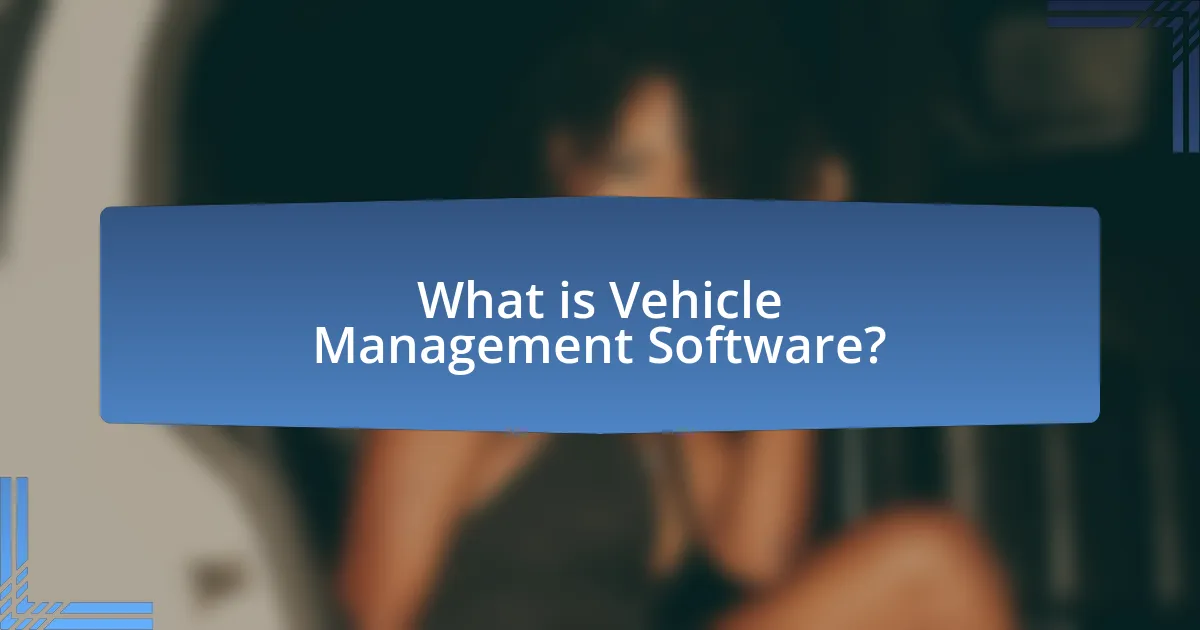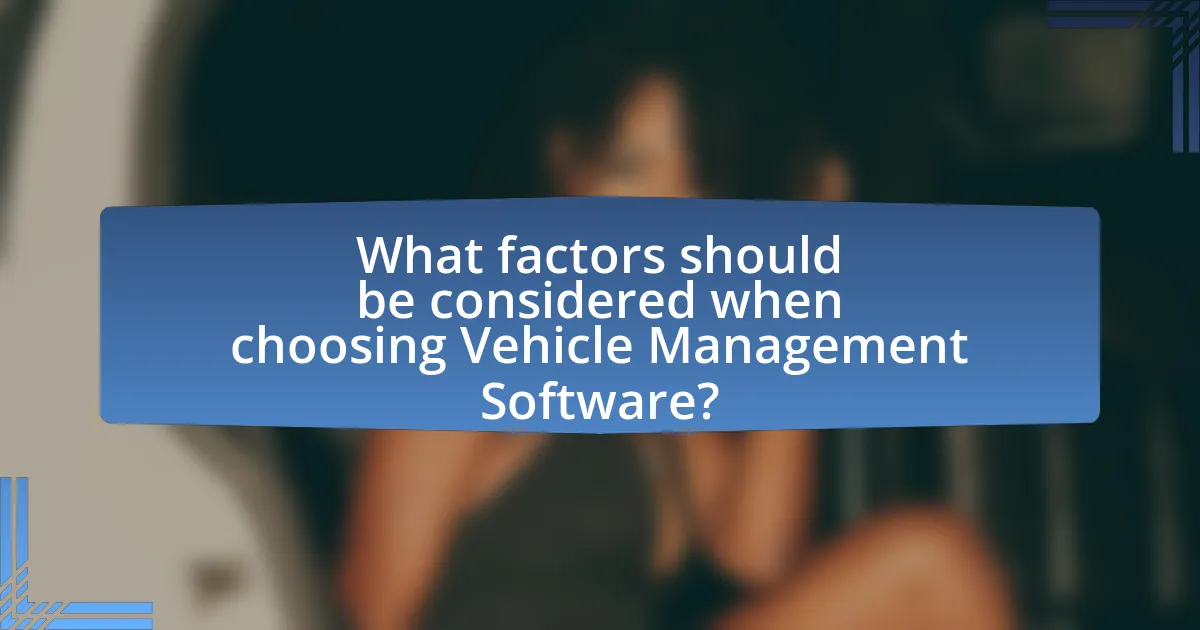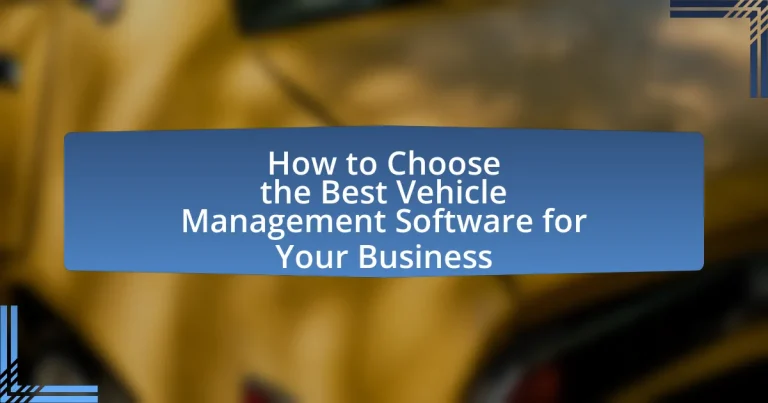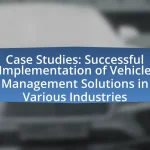Vehicle Management Software is a digital tool designed to enhance the management of vehicle fleets by offering features such as tracking maintenance, monitoring fuel consumption, and managing driver information. The article outlines how this software functions, its key features, and the benefits it provides, including cost savings and improved operational efficiency. It also discusses factors to consider when selecting software, such as functionality, scalability, user experience, and ongoing support. Additionally, the article reviews popular software options, compares their features, and highlights best practices for implementation to ensure a smooth transition and successful utilization in business operations.

What is Vehicle Management Software?
Vehicle Management Software is a digital solution designed to streamline the management of a fleet of vehicles. This software typically includes features for tracking vehicle maintenance, monitoring fuel consumption, managing driver information, and ensuring compliance with regulations. According to a report by MarketsandMarkets, the global vehicle management software market is expected to grow from $1.5 billion in 2020 to $3.5 billion by 2025, indicating a significant demand for such solutions in optimizing fleet operations.
How does Vehicle Management Software function?
Vehicle Management Software functions by integrating various tools and features to monitor, track, and manage a fleet of vehicles efficiently. This software typically includes functionalities such as GPS tracking, maintenance scheduling, fuel management, and driver behavior analysis, allowing fleet managers to optimize operations and reduce costs. For instance, GPS tracking enables real-time location monitoring, which can improve route planning and enhance security. Additionally, maintenance scheduling helps ensure that vehicles are serviced regularly, thereby extending their lifespan and minimizing downtime. The effectiveness of Vehicle Management Software is supported by industry reports indicating that companies utilizing such systems can reduce operational costs by up to 20% through improved efficiency and resource management.
What are the key features of Vehicle Management Software?
Vehicle Management Software typically includes features such as fleet tracking, maintenance scheduling, fuel management, and driver management. Fleet tracking allows businesses to monitor vehicle locations in real-time, enhancing route optimization and reducing operational costs. Maintenance scheduling automates reminders for service and repairs, which helps in prolonging vehicle lifespan and ensuring compliance with safety regulations. Fuel management features track fuel consumption and expenses, enabling businesses to identify inefficiencies and reduce costs. Driver management functionalities assist in monitoring driver behavior, ensuring safety, and improving overall fleet performance. These features collectively enhance operational efficiency and reduce costs for businesses managing a fleet.
How do these features enhance fleet operations?
These features enhance fleet operations by improving efficiency, reducing costs, and increasing safety. For instance, real-time tracking allows fleet managers to monitor vehicle locations, optimizing routes and minimizing fuel consumption. According to a study by the American Transportation Research Institute, implementing GPS tracking can lead to a 10-15% reduction in fuel costs. Additionally, maintenance alerts help prevent breakdowns, ensuring vehicles remain operational and reducing downtime. This proactive approach to vehicle management not only saves money but also enhances overall fleet productivity.
What are the benefits of using Vehicle Management Software?
Vehicle Management Software enhances operational efficiency by streamlining fleet management processes. This software provides real-time tracking of vehicles, which improves route optimization and reduces fuel costs. Additionally, it facilitates maintenance scheduling, ensuring vehicles are serviced on time, thereby extending their lifespan and minimizing downtime. According to a study by the American Transportation Research Institute, effective fleet management can lead to a 10-15% reduction in operational costs. Furthermore, the software aids in compliance with regulations by maintaining accurate records, which can prevent costly fines. Overall, the benefits of using Vehicle Management Software include cost savings, improved efficiency, and enhanced compliance.
How does it improve efficiency in fleet management?
Fleet management efficiency improves through real-time tracking and data analytics. Real-time tracking allows fleet managers to monitor vehicle locations, optimize routes, and reduce fuel consumption, leading to cost savings. Data analytics provides insights into vehicle performance, maintenance needs, and driver behavior, enabling proactive decision-making. According to a study by the American Transportation Research Institute, optimizing routes can reduce fuel costs by up to 10%, demonstrating the tangible benefits of improved efficiency in fleet management.
What cost savings can businesses expect from using this software?
Businesses can expect significant cost savings from using vehicle management software, primarily through reduced operational expenses and improved efficiency. For instance, studies show that companies can save up to 20% on fuel costs by optimizing routes and reducing idle time, which the software facilitates. Additionally, maintenance scheduling features can lead to a decrease in repair costs by up to 30% by ensuring timely servicing and preventing major breakdowns. Furthermore, enhanced tracking and reporting capabilities can minimize administrative overhead, potentially saving businesses thousands of dollars annually in labor costs.

What factors should be considered when choosing Vehicle Management Software?
When choosing Vehicle Management Software, key factors to consider include functionality, scalability, user-friendliness, integration capabilities, and cost. Functionality ensures the software meets specific needs such as tracking, maintenance scheduling, and reporting. Scalability is crucial for accommodating business growth, allowing the software to adapt as the fleet expands. User-friendliness impacts employee adoption and efficiency, while integration capabilities with existing systems enhance overall operational efficiency. Cost should be evaluated not only in terms of initial investment but also ongoing maintenance and support expenses. These factors collectively ensure that the selected software effectively supports business operations and enhances fleet management efficiency.
How do business needs influence software selection?
Business needs significantly influence software selection by determining the specific functionalities and features required to support operational goals. For instance, a company focused on improving fleet efficiency may prioritize software that offers real-time tracking and maintenance scheduling. According to a survey by Software Advice, 60% of businesses reported that aligning software capabilities with their operational needs was a critical factor in their selection process. This alignment ensures that the chosen software not only meets current requirements but also scales with future business growth, thereby enhancing overall productivity and cost-effectiveness.
What specific functionalities should businesses prioritize?
Businesses should prioritize functionalities such as real-time tracking, maintenance scheduling, and reporting analytics in vehicle management software. Real-time tracking enables businesses to monitor vehicle locations and optimize routes, which can lead to reduced fuel costs and improved delivery times. Maintenance scheduling helps prevent breakdowns and extends vehicle lifespan by ensuring timely servicing, which is crucial for operational efficiency. Reporting analytics provide insights into vehicle performance and operational costs, allowing businesses to make data-driven decisions that enhance productivity and reduce expenses. These functionalities are essential for maximizing efficiency and minimizing costs in vehicle management.
How can scalability impact the choice of software?
Scalability significantly impacts the choice of software by determining whether the software can grow alongside the business’s needs. When selecting vehicle management software, businesses must consider if the software can handle increased data volume, user load, and additional features as the organization expands. For instance, a study by Gartner indicates that 70% of businesses face challenges with software that cannot scale effectively, leading to operational inefficiencies and increased costs. Therefore, choosing scalable software ensures long-term viability and adaptability, aligning with future growth objectives.
What role does user experience play in software selection?
User experience plays a critical role in software selection by directly influencing user satisfaction and adoption rates. A positive user experience ensures that the software is intuitive, efficient, and meets the specific needs of users, which can lead to increased productivity and reduced training time. Research indicates that 70% of software projects fail due to poor user experience, highlighting its importance in the selection process. Therefore, prioritizing user experience in software selection can significantly enhance the likelihood of successful implementation and long-term usage.
How important is the software’s interface for daily operations?
The software’s interface is crucial for daily operations as it directly impacts user efficiency and productivity. A well-designed interface enhances usability, allowing users to navigate the software quickly and perform tasks with minimal errors. Research indicates that intuitive interfaces can reduce training time by up to 50%, leading to faster adoption and improved operational workflows. Therefore, the interface significantly influences how effectively employees can utilize the software in managing vehicle operations.
What training and support options should be considered?
When selecting vehicle management software, consider comprehensive training and ongoing support options. Effective training should include user manuals, video tutorials, and live training sessions to ensure all users understand the software’s features and functionalities. Ongoing support options should encompass a dedicated helpdesk, online chat support, and regular software updates to address any issues and improve user experience. Research indicates that companies providing robust training and support see a 30% increase in user satisfaction and software adoption rates, highlighting the importance of these options in maximizing the software’s effectiveness for business operations.

What are the top Vehicle Management Software options available?
The top Vehicle Management Software options available include Fleet Complete, Verizon Connect, and Samsara. Fleet Complete offers comprehensive fleet tracking and management features, enabling businesses to monitor vehicle locations and driver behavior in real-time. Verizon Connect provides advanced telematics solutions, enhancing operational efficiency through data analytics and reporting. Samsara combines GPS tracking with maintenance management, ensuring vehicles are serviced on time and reducing downtime. These software solutions are recognized for their effectiveness in optimizing fleet operations and improving overall business performance.
How do different software solutions compare in features?
Different software solutions for vehicle management vary significantly in features, impacting their suitability for specific business needs. For instance, some solutions offer comprehensive fleet tracking capabilities, including GPS integration and real-time monitoring, while others may focus on maintenance scheduling and reporting functionalities. A study by Software Advice in 2021 indicated that 70% of businesses prioritize features like fuel management and driver behavior analysis when selecting software. Additionally, platforms such as Fleet Complete provide advanced analytics and mobile access, whereas simpler solutions may lack these capabilities, making them less effective for larger fleets. Thus, the comparison of features is crucial for businesses to select the most appropriate vehicle management software.
What are the strengths and weaknesses of popular software options?
Popular software options for vehicle management, such as Fleet Complete, Verizon Connect, and Samsara, exhibit distinct strengths and weaknesses. Fleet Complete offers comprehensive tracking and reporting features, enhancing operational efficiency, but may have a steep learning curve for new users. Verizon Connect excels in real-time GPS tracking and driver behavior analysis, yet its pricing can be prohibitive for smaller businesses. Samsara provides an intuitive interface and robust analytics, but some users report limitations in customer support. These strengths and weaknesses highlight the importance of aligning software capabilities with specific business needs for optimal vehicle management.
How do pricing models vary among different providers?
Pricing models among different vehicle management software providers vary significantly, typically categorized into subscription-based, pay-per-use, and one-time licensing fees. Subscription-based models, such as those offered by providers like Fleet Complete, charge a recurring fee that often includes updates and support, appealing to businesses seeking predictable costs. Pay-per-use models, exemplified by companies like Geotab, charge based on the actual usage of the software, which can benefit businesses with fluctuating needs. One-time licensing fees, seen in traditional software providers, require an upfront payment for perpetual use but may incur additional costs for updates and support. These variations allow businesses to select a pricing model that aligns with their operational needs and budget constraints.
What user reviews and testimonials can inform your decision?
User reviews and testimonials can significantly inform your decision by providing insights into the real-world performance and user satisfaction of vehicle management software. For instance, reviews often highlight features such as ease of use, customer support quality, and integration capabilities with existing systems. A study by Capterra found that 70% of users rely on reviews to make software purchasing decisions, indicating their importance in evaluating options. Additionally, testimonials from businesses similar to yours can reveal how the software addresses specific challenges, enhancing your understanding of its practical benefits and limitations.
How can customer feedback highlight potential issues?
Customer feedback can highlight potential issues by providing direct insights into user experiences and satisfaction levels. When customers express concerns or dissatisfaction, they often identify specific problems related to functionality, usability, or service quality. For instance, a survey conducted by the American Customer Satisfaction Index found that 70% of customers who reported issues with a product or service were likely to share their feedback, which can reveal patterns of recurring problems. Analyzing this feedback allows businesses to pinpoint areas needing improvement, ensuring that vehicle management software meets user expectations and enhances overall performance.
What should you look for in user experiences with the software?
When evaluating user experiences with vehicle management software, focus on usability, functionality, and customer support. Usability refers to how intuitive and user-friendly the software is, which can significantly impact user satisfaction and efficiency. Functionality encompasses the features offered, such as tracking capabilities, reporting tools, and integration with other systems, which are essential for effective vehicle management. Customer support is critical, as responsive and knowledgeable assistance can enhance the overall user experience and resolve issues promptly. Research indicates that 70% of users prioritize ease of use and support when selecting software, highlighting the importance of these factors in user experiences.
What are the best practices for implementing Vehicle Management Software?
The best practices for implementing Vehicle Management Software include conducting a thorough needs assessment, selecting a user-friendly platform, ensuring data integration, providing comprehensive training, and establishing clear performance metrics. Conducting a needs assessment helps identify specific requirements and functionalities essential for the organization, ensuring the software aligns with operational goals. Selecting a user-friendly platform enhances user adoption and minimizes resistance to change, as studies show that intuitive interfaces lead to higher engagement rates. Ensuring data integration with existing systems, such as GPS and maintenance tracking, facilitates seamless operations and improves data accuracy. Providing comprehensive training equips staff with the necessary skills to utilize the software effectively, which is critical as organizations that invest in training report a 30% increase in productivity. Establishing clear performance metrics allows organizations to measure the software’s impact on efficiency and cost savings, enabling continuous improvement and optimization of vehicle management processes.
How can businesses ensure a smooth transition to new software?
Businesses can ensure a smooth transition to new software by implementing a structured change management process. This involves thorough planning, including assessing current systems, defining clear objectives, and involving stakeholders throughout the transition. Research indicates that organizations that engage employees in the process experience a 70% higher success rate in software adoption. Additionally, providing comprehensive training and support during the transition helps mitigate resistance and enhances user proficiency, further facilitating a seamless integration of the new software into daily operations.
What ongoing maintenance and updates are necessary for success?
Ongoing maintenance and updates necessary for success in vehicle management software include regular software updates, data backups, and system performance monitoring. Regular software updates ensure that the system remains secure and incorporates the latest features, which is critical as cyber threats evolve; for instance, a 2021 report by Cybersecurity Ventures predicted that cybercrime would cost the world $10.5 trillion annually by 2025. Data backups protect against data loss, ensuring business continuity; according to a study by the National Archives and Records Administration, 93% of companies that lost their data center for 10 days or more filed for bankruptcy within a year. System performance monitoring helps identify and resolve issues proactively, maintaining optimal functionality and user satisfaction.

